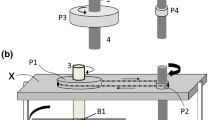Conclusions
-
1.
The rectifying instrument's error due to the wave form of current or voltage depends on the frequency and amplitude of the effective harmonics and is a periodic function of the phase difference between the higher and the 1st harmonic.
-
2.
The maximum rectifying instrument's waveform error with a 10% content of higher harmonics with respect to the fundamental* does not exceed 5% irrespective of the instruments's class of accuracy.
-
3.
A rise in the content of effective harmonics displaces the error curve towards negative values.
-
4.
The maximum error is produced by a curve containing the 1st and 3rd harmonics, and its maximum possible value occurs for a phase difference of 180° and a ratio of A3/A1 ≈ 0.6 between them.
-
5.
A rectifying instrument's error with a voltage (current) curve containing several harmonics (up to 6) does not exceed the maximum error due to the 3rd harmonic for the same nonlinear distortion coefficient.
Similar content being viewed by others
Literature cited
K. B. Karandeev, Semiconductor Rectifiers in Measurement Technology [in Russian], Acad. Sci. UkrSSR Press, Kiev, 1954.
M. Kh. Shliomovich, Investigation and Design of Rectifying Ammeters and Voltmeters for Audio Frequencies. Dissertation. MGIMIP (Moscow State Institute of Mechanical and Measuring Instruments) (Moscow, 1952).
A. Cunliffe. J. Sci. Instr. Vol. 25. No. 9 (1948).
H. Gommlich, Elektronische Rundschau, No. 4 (1961).
F. Klutke. ENT. Bd. 15. H. 10 (1938).
H. Pfannenmuller, ETZ. H. 39 (1939).
J. E. Parton and W. D. Sutherland, Trans. Soc. Instr. Technol., Vol. 6, No. 4 (1954).
G. Szabó. Arch. Techn. Messen. April, H. 279 (1959).
Investigation of the Effect of Current and Voltage Wave-forms on the Readings of Electrical Measuring Instruments. Report to the VNIIEP (All-Union Scientific Research Institute of Electrical Measuring Instruments) (Leningrad, 1960).
K. B. Karandeev and I. A. Zakhariya, “Analysis of errors in rectifying instruments by the switching method”. Problems of Automation and Measurement Technology. Scientific notes of the IMA (Institute of Mechanization and Automatton), Acad. Sci. UkrSSR, Kiev, Vol. 4, No. 3 (1955).
Effektivwert-Gleichrichter für Drehspulinstrumente. Elektronische Rundschau, No. 4 (1961).
H. Boucke, Arch. elektrischen Ubertragung, Bd. 4, No. 7 (1950).
K. B. Karandeev and I. A. Zakhariya, Izmeritel'naya tekhnika, No. 7 (1960).
Ya. S. Averbukh. “Detecting Voltmeters and Milliammeters”. IÉST, No. 10 (1933).
Ya. A. Bezikovich, VNIIM Transactions, No. 14, 74 (1953).
I. A. Zakhariya, Experimental Technique for Investigating the Waveform Error in Rectifying Instruments. Dissertation at L'vov Polytechnic Institute, 1950.
W. Grunert and H. Hueter, ETZ, H. 1 (1940).
F. Kummel, ETZ-A, H. 23 (1953).
K. Maier, Arch. Techn. Messen. Juni, J. 82-6 (1940).
H. Pfannenmüller, Arch. Techn. Messen, November, J. 026-2 (1933).
M. Teissie-Solier and R. Lacoste, Electricite, An. 36, No. 185 (1952).
Rights and permissions
About this article
Cite this article
Bogorad, L.M. Effect of the current and voltage wave form on the readings of rectifying instruments. Meas Tech 6, 225–230 (1963). https://doi.org/10.1007/BF01409261
Issue Date:
DOI: https://doi.org/10.1007/BF01409261




